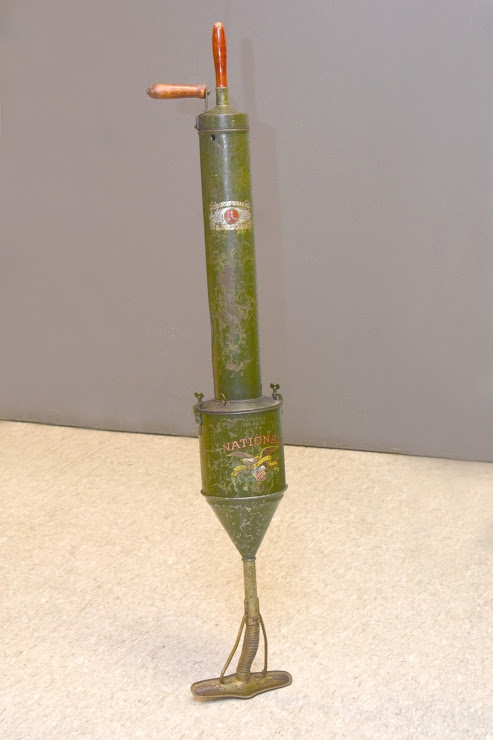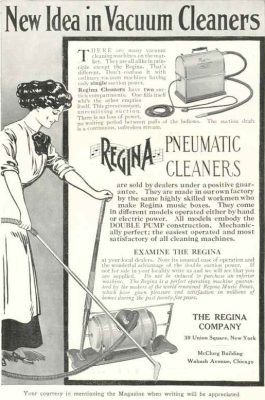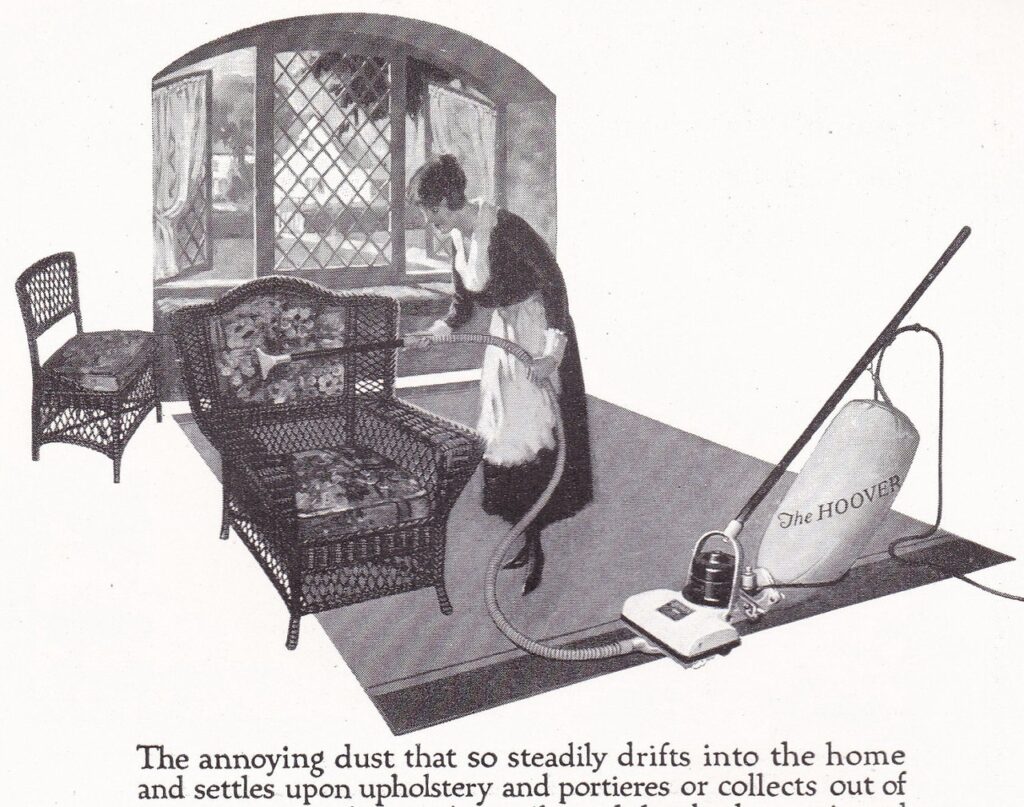People in the early 20th century witnessed the invention of all kinds of household tools we take for granted today, such as the vacuum cleaner, laundry machine, and refrigerator. This is a manual vacuum cleaner from 1911 at the Wisconsin Historical Museum.
This small upright vacuum was designed to be operated by hand and easy to carry around. It was made of metal, and had one wooden handle on the side and another at the top of the canister. The nozzle on the bottom was attached to the canister by a bendable metal tube. The nozzle head is similar to the ones on modern vacuums, and can be used on carpet, hard flooring, or upholstery. Instead of electricity, this vacuum was powered by the user moving the top handle up and down like a plunger. This action caused the vacuum to suck air in and push it out again. When the nozzle sucked air in, it also sucked up dirt and dust, which was then trapped inside the canister.
To operate the vacuum, the user held the side handle to guide the vacuum cleaner while plunging the top handle up and down. This vacuum was originally painted green, although today much of the paint has chipped off. The company logo features a bald eagle with a shield and the words “National Vacuum Cleaner,” as well as the name of the sales company located in Chicago and Philadelphia.
Looking at this hand-powered vacuum, you might think that it was invented before the electric vacuum cleaner. However, electric vacuum cleaners already existed by the time this manual vacuum was invented. The reason there was still a market for hand-powered vacuums was that in 1911, most people in the rural midwest did not yet have electricity in their homes. This vacuum cleaner allowed rural Wisconsinites to bring the latest modern convenience into their homes at an affordable price.


Vacuum companies claimed that their invention was more sanitary than using a broom, and would help get rid of germs in the home. In 1911, scientists had only known how germs worked for a generation or so, and most people were just beginning to understand what they were. In 1911, germs and sanitation was a major topic of conversation, so it is no surprise that the vacuum company tapped into the public’s new fear of germs to sell their product.
Although it was a new technology on the market, this vacuum wasn’t necessarily more convenient than a broom. To work this vacuum, a person had to pump continuously with one arm while guiding it with the other. The nozzle could only suck up a little dirt at a time, and if you lost speed, you would have to go over the same spot again. Using this vacuum could make your arms tired, and it took longer than sweeping with a broom!
Knowing this, why would anyone buy this vacuum? Perhaps, consumers did not know all this when they decided to buy pump vacuums like this one. Or, maybe they did not mind, because the vacuum was new and different. What do you think?
Further Questions
Even though the design of this vacuum is not perfect, it does have some features we still see in modern vacuums: the upright canister, the shape of the nozzle, and perhaps most importantly, the lightweight portable design. The ads promise that it is so light even a child can use it! Later inventors kept the parts of this technology that worked and improved on the parts that did not.
Think about a time when you got excited about new technology. Have you, or someone you know, ever purchased something online without seeing it in person first? Or seen someone demonstrate a new gadget that was so cool you just had to have one? Have you ever felt disappointed by a new product that did not quite live up to the hype? If so, you can imagine the ups and downs of being a consumer in the early 1900s.
Written by Laurel Miller, October 2018.

Want to learn more about the Electricity in Rural America?
This film, created in 1940 by the U.S. Rural Electrification Administration, was created to show farmers how electricity could improve their lives.
Click on the video title (at left) to open in YouTube.

Wisconsin Historical Museum
This object history is part of the Wisconsin Historical Museum Mini Tour.

